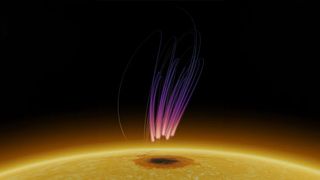Astronomy
Explore Astronomy
Latest about Astronomy

Intense solar storm opens '2-way highway' for charged particles, sparking rare auroras on the sun
By Sharmila Kuthunur published
Last year, Earth spewed charged particles into the sun in a rare cosmic event that has surprised scientists.

The blue supermoon will 'swallow' Saturn tonight — here's when the rare 'lunar occultation' begins
By Gretchen Rundorff published
Here's everything you need to know to see the moon as it occults, or passes completely in front of, the bright planet Saturn tonight.

'Final parsec problem' that makes supermassive black holes impossible to explain could finally have a solution
By Jonathan Gilbert published
A new study helps solve the "final parsec problem" that has made supermassive black hole formation impossible to explain, pointing to a strange form of dark matter as the key.

Why is a 'once-in-a-decade' Supermoon Blue Moon happening twice in 2 years?
By Daisy Dobrijevic published
A 'once in a blue moon' event might not be as infrequent as you think.

The sun might've just had a record-breaking number of visible sunspots
By Meredith Garofalo published
On Aug. 8, NASA scientists may have spotted a record number of sunspots when hundreds of individual spots were estimated to occur within 24 hours.

Catastrophic collision between Milky Way and Andromeda galaxies may not happen after all, new study hints
By Ben Turner published
Astronomers have long predicted that a collision between our galaxy and nearby Andromeda could be inevitable, but new calculations suggest this may be an over exaggeration.

Tonight's 'Sturgeon Moon' will be the 1st 'blue supermoon' of 2024: Here's how to see it at its biggest and best
By Jamie Carter last updated
The year's first supermoon is also the third full moon in a summer that includes four, making it a 'blue supermoon'. Here's how to see August's full Sturgeon Moon rise.

Space photo of the week: James Webb telescope catches baby stars roaring to life
By Jamie Carter published
A new image of the Serpens Nebula captured by the James Webb Space Telescope shows that when clouds collapse to form stars, all of those stars spin in the same direction.
Sign up for the Live Science daily newsletter now
Get the world’s most fascinating discoveries delivered straight to your inbox.


